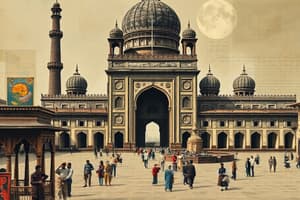Podcast
Questions and Answers
Who was the first ruler of the Delhi Sultanate?
Who was the first ruler of the Delhi Sultanate?
- Razia Sultana
- Ghiyasuddin Tughlaq
- Prithviraj Chauhan
- Qutb al-Din Aybak (correct)
Which dynasty is considered the most significant and longest-lasting in the Delhi Sultanate?
Which dynasty is considered the most significant and longest-lasting in the Delhi Sultanate?
- Sayyid Dynasty
- Tughlaq Dynasty (correct)
- Khilji Dynasty
- Mamluk Dynasty
Why did the Delhi Sultanate emerge during the 13th century?
Why did the Delhi Sultanate emerge during the 13th century?
- After a period of decline for Hindu empires (correct)
- To form an alliance with the Mongol Empire
- To establish a new empire outside India
- Due to unity among Hindu-ruled kingdoms
Which geographical area did the Delhi Sultanate cover?
Which geographical area did the Delhi Sultanate cover?
What was the ethnic diversity of rulers in the Delhi Sultanate?
What was the ethnic diversity of rulers in the Delhi Sultanate?
Which dynasty succeeded the Mamluk Dynasty in ruling the Delhi Sultanate?
Which dynasty succeeded the Mamluk Dynasty in ruling the Delhi Sultanate?
What was a significant cultural impact of the Delhi Sultanate?
What was a significant cultural impact of the Delhi Sultanate?
How did the Delhi Sultanate blend architectural styles in its monuments?
How did the Delhi Sultanate blend architectural styles in its monuments?
Which administrative measure was implemented by the sultans of the Delhi Sultanate to promote Islamic learning?
Which administrative measure was implemented by the sultans of the Delhi Sultanate to promote Islamic learning?
What characterized the Delhi Sultanate's centralized administration?
What characterized the Delhi Sultanate's centralized administration?
Which architectural achievements are associated with the Delhi Sultanate?
Which architectural achievements are associated with the Delhi Sultanate?
What cultural fusion was evident in the architectural styles during the Delhi Sultanate?
What cultural fusion was evident in the architectural styles during the Delhi Sultanate?
Flashcards
Delhi Sultanate
Delhi Sultanate
A period in Indian history from the mid-13th to early 16th century marked by Muslim rule.
Mamluk Dynasty
Mamluk Dynasty
The first dynasty of the Delhi Sultanate, starting with Qutb al-Din Aybak in 1206.
Khilji Dynasty
Khilji Dynasty
The second dynasty in the Delhi Sultanate known for significant territorial expansion and cultural influence.
Tughlaq Dynasty
Tughlaq Dynasty
Signup and view all the flashcards
Sayyid Dynasty
Sayyid Dynasty
Signup and view all the flashcards
Indo-Islamic culture
Indo-Islamic culture
Signup and view all the flashcards
Qutb Minar
Qutb Minar
Signup and view all the flashcards
Tughlaqabad Fort
Tughlaqabad Fort
Signup and view all the flashcards
Provincial governors (subahdars)
Provincial governors (subahdars)
Signup and view all the flashcards
Land revenue system (zabt)
Land revenue system (zabt)
Signup and view all the flashcards
Madrasas
Madrasas
Signup and view all the flashcards
Indo-Islamic architecture
Indo-Islamic architecture
Signup and view all the flashcards
Study Notes
The Delhi Sultanate: A Tale of Dynasties, Culture, and Rule
The Delhi Sultanate, stretching from the mid-13th to the early 16th century, brought a new era to the Indian subcontinent, characterized by political upheaval, cultural richness, and architectural prowess. This article will delve into the history, rulers, culture, administration, and architecture of the Delhi Sultanate, offering a glimpse into this significant period of Indian history.
History
The Delhi Sultanate emerged during a time of decline for the Hindu-ruled kingdoms following the disintegration of the Hindu empires, such as the Chola, Chalukya, and the most dominant, the Rajput-dominated Chauhan Empire. The first sultanate, the Mamluk Dynasty, began in 1206 when Qutb al-Din Aybak, a slave of the Ghuri Empire, seized the throne after the death of the last Hindu king, Prithviraj Chauhan. The succeeding dynasties—the Khilji, Tughlaq, and Sayyid—also ruled over this region between the Yamuna and Ganges rivers, making the capital city of Delhi a center of power and culture for more than three centuries.
Rulers
The Delhi Sultanate was ruled by several dynasties comprising various ethnicities and religious backgrounds. The Mamluk Dynasty, the first to establish the Sultanate, was succeeded by the Khilji Dynasty. The Tughlaq Dynasty, which started with the reign of Ghiyasuddin Tughlaq, is considered the most significant and longest-lasting of the Sultanate dynasties. The Sayyid Dynasty, lastly, ruled during the final years of the Sultanate.
Culture
The Delhi Sultanate ushered in a cultural renaissance, blending Indo-Islamic influences with elements from the Persian, Central Asian, and Hindu traditions. The introduction of Persian poetry, music, and literature to India brought a new style and elegance to the region's cultural scene. The Sultanate also gave rise to the development of Indo-Islamic architecture, represented by monuments such as the Qutb Minar, Tughlaqabad Fort, and Feroz Shah Kotla, which showcased the fusion of Persian, Hindu, and Central Asian architectural styles.
Administration
The Delhi Sultanate's administration was based on the existing Hindu administrative traditions, such as the system of provincial governors (subahdars) and the land revenue system (zabt). The sultans also implemented new administrative measures, including a standing army (jama'at-i-khas) and the establishment of religious institutions (madrasas) to promote Islamic learning. The administration was centralized, with the sultan serving as the supreme authority, controlling all aspects of the state.
Architecture
The Delhi Sultanate is undeniably renowned for its architectural achievements, many of which still stand today. With structures such as the Qutb Minar, Tughlaqabad Fort, and Feroz Shah Kotla, the Delhi Sultanate marked a significant advancement in the field of Indo-Islamic architecture. The fusion of Persian, Hindu, and Central Asian architectural styles resulted in the creation of unique and stunning monuments.
The Delhi Sultanate was a period of transformation for the Indian subcontinent. It brought political, cultural, and architectural innovations, blending Indo-Islamic influences with elements from the Persian, Central Asian, and Hindu traditions. The Delhi Sultanate's legacy continues to shape the region's history, art, and culture, providing an enduring reminder of this pivotal period in India's past.
Studying That Suits You
Use AI to generate personalized quizzes and flashcards to suit your learning preferences.




